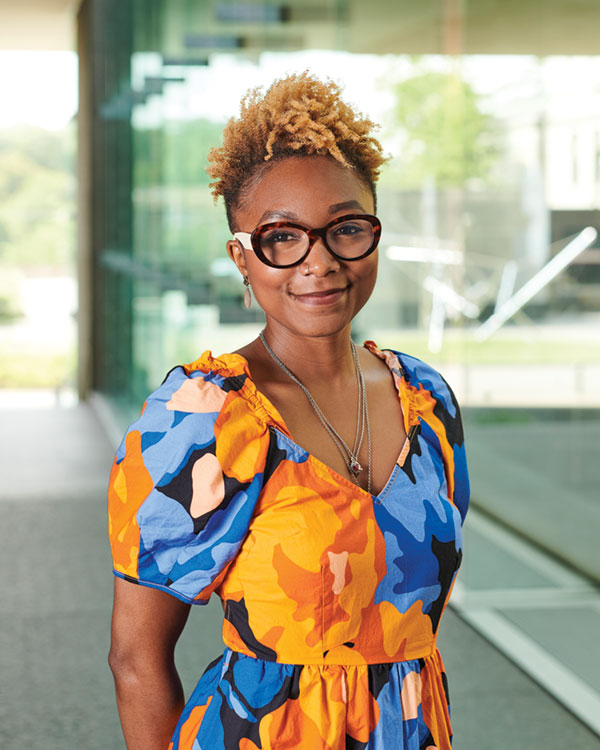 Photo: Sean Eaton
Photo: Sean EatonAs a high school student in Florida, Tiffany Sims was immersed in the world of dance when her Advanced Placement art history teacher, Lacy Van Reeth, opened Sims’ eyes to wider possibilities. “She told us about the new director of the Pérez Art Museum Miami, Franklin Sirmans,” Sims recalls, “When she displayed his picture on the projector for the class to see, I thought to myself, ‘Oh, my goodness! That’s a Black man, in this high position within the museum world.’ It opened my eyes to the possibility of myself being within the art world.” Sims, 25, went on to the University of Florida where she graduated with a B.A. in art history in 2021 and then joined the University of Pittsburgh’s Hot Metal Bridge post-baccalaureate fellowship program. In May 2022, Sims became Carnegie Museum of Art’s Margaret Powell Curatorial Fellow, working alongside museum curators and staff to breathe life into the Milton and Sheila Fine Collection exhibition.
Q: Your research has been focused on Black contemporary art and performance art studies. How did you come to focus on these areas of interest?
A: I’ve always known that I gravitated towards Black contemporary art, but the performance and dance side of my research came out within the past two years. During 2020, I reached out to a couple of curators that I admire. Through those conversations, they reaffirmed that. They’re like, “Oh, you need to use your dance background that you’re more familiar with to help ground you in your research.” Once I stepped into the Hot Metal Bridge [Post-Bac] Fellowship at the University of Pittsburgh, I was like, OK, this is my opportunity to explore artists, performance artists, and Black contemporary artists that relate to what I’ve been thinking about.
Q: What attracted you to Black contemporary art?
A: I gravitated towards Black contemporary art because I saw myself and lived experience reflected within the art. In high school, I was obsessed with Kerry James Marshall and Toyin Ojih Odutola—treatment of skin color and portraiture was something I had never seen before. Learning about the Harlem Renaissance and Black Arts Movement shed a light on the richness and beauty of the African American experience.
Q: Can you talk about your involvement with the Milton and Sheila Fine exhibition?
A: When I arrived here about a year ago, this was the first project that they said that I was going to work on. So I have been taking a deep dive and learning about how the Fines collected and why they collected, and also learning that the collection is embedded within our own collection. I’ve done the research side of it, I have done work for the publication. I wrote a chronology on Milton Fine. I also learned about rights and reproduction for images for the publication. This being the first exhibition that I’ve ever worked on, learning how Eric [Crosby, director of Carnegie Museum of Art] is thinking about a checklist and how a checklist goes from being a piece of paper in someone’s mind, then becomes what the audience sees. I’ve learned so much from him throughout this process.
Q: What’s been the most fascinating aspect of your work?
A: When I started out the fellowship, I was intentional to set short-term and long-term goals that I would be able to see through these two years. I’m honestly happy to say that I’ve gotten halfway through all of them—learning about artwork acquisition, how grants are written, about funding for exhibitions and the institution as a whole, learning from each curator, their own curatorial style, and how they approach artists, how they approach their own acquisition process. It’s just a full range of experiences that I didn’t know that I was going to have.
Q: What has been your greatest contribution to the museum?
A: I would say that bringing my own research within the museum. I think that might be a new aspect of what I’m bringing—looking into how performance art and dance can be embedded within our programs, galleries, and exhibitions.
Q: What’s something that you were really fascinated to learn?
A: The process of acquiring an artwork. From the outside looking in, I didn’t realize how long it could be. I just didn’t know the process at all.
Q: What’s next for you after the fellowship ends?
A: I am looking forward to opportunities to grow and expand my own curatorial practice and research. Along with a moment to pause and reflect on these past two years of my fellowship, I am excited for what’s to come!
The Margaret Powell Fellowship is made possible by Arts, Equity, & Education Fund.
Receive more stories in your email
Sign upTags:
Art